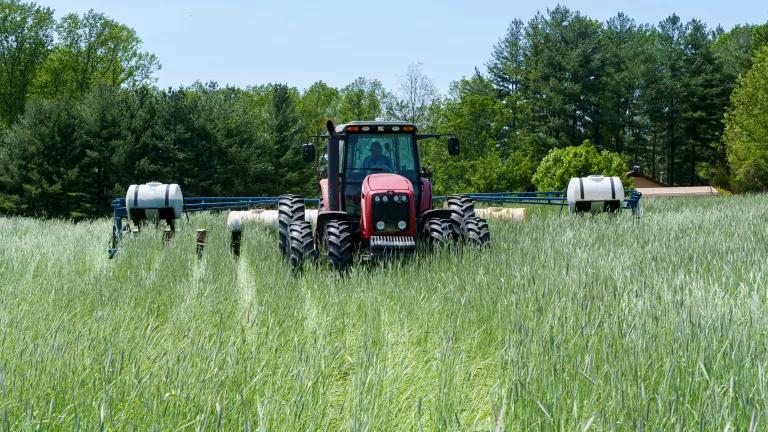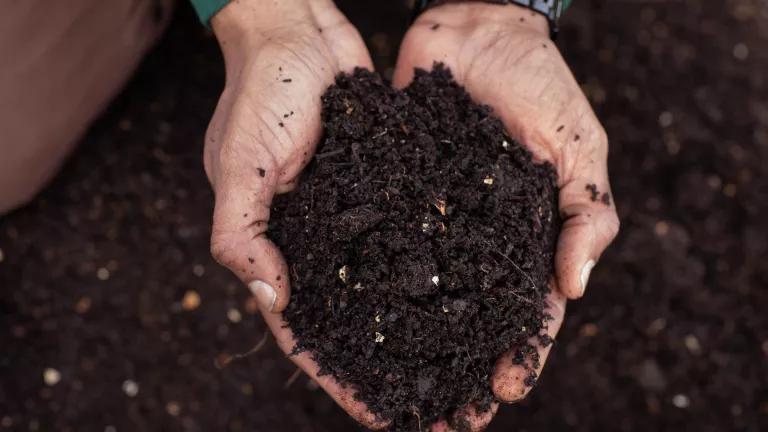UPDATE: The House passed the Inflation Reduction Act (IRA) of 2022 on August 12, 2022. The package includes nearly $20 billion for conservation, $5 billion for forestry, $14 billion for rural clean energy, and nearly $6 billion in relief for underserved farmers and ranchers. After the IRA becomes law, government agencies must swiftly use their authorities and this funding to accelerate climate action and to promote a regenerative future for American agriculture, including:
- Widespread adoption of climate-friendly and regenerative conservation practices, including organic agriculture
- Reduced public support for concentrated animal feeding operations (CAFOs) and industrial animal agriculture
- Prompt and flexible debt relief, loan modifications, and other support for underserved producers—especially important for farmers and ranchers of color who have suffered financially due to longstanding discrimination by the U.S. Department of Agriculture
- Utilizing Greenhouse Gas Pollution Planning and Implementation Grants to reduce greenhouse gases, like methane, through proper management of food scraps and investing in other programs, policies, and infrastructure to reduce food waste.
The announcement of a reconciliation deal in the Senate and the release of the Inflation Reduction Act of 2022 marks a watershed moment for climate-friendly agriculture—the latter centering tens of billions of dollars around climate mitigation and adaptation for a more sustainable future. The funding includes nearly $21 billion for conservation, $5 billion for forestry, and $14 billion for Rural Development that ensures rural America is at the table of the clean energy revolution. We support this bill and urge its swift passage.
This investment in conservation and forestry would could increase the amount of carbon stored by our natural and working lands by 76 MMT tons of carbon by 2030. This is an important step in redefining our relationship with the land, and is equivalent to removing over 16 million cars from the road.
Agriculture is a key building block for managing emissions as “U.S. agriculture emitted an estimated 698 million metric tons of carbon-dioxide equivalent in 2018”—meaning agriculture was responsible for 10 percent of U.S. greenhouse gas emissions. And a recent U.S. EPA report found that agricultural production accounts for nearly half of the climate footprint of our food system.

Environmental footprint of the U.S. cradle-to-consumer food supply
EPA, From Farm to Kitchen: The Environmental Impacts of Food Waste (Nov. 2021)
Agricultural lands also face the difficult challenge of confronting climate change where extreme temperatures and dramatic swings in weather make agriculture even less predictable, challenging the stability of our food system. Our policymakers are increasingly recognizing the importance of addressing the climate challenges facing our food system. Key investments in the Inflation Reduction Act that help farmers and ranchers build healthy soil and use climate friendly farming practices that will support a transition to greater health and resilience in U.S. food production.

NRCS Soil Comparisons
Double Down on Climate, Environment, Resiliency Funding
The bedrock conservation programs at USDA are severely underfunded, which limits the USDA’s ability to address climate change and incentivize the long investments in game changing conservation practices. These conservation programs work, and are a critical tool to empower farmers in the fight against climate change, helping ensure our food system is more resilient, and protecting clean water and providing habitat.
Building a Greater Understanding of the Climate Benefits of Healthy Soil
Regenerative agriculture and healthy soils practices that underpin this philosophy of land management represent a framework for agriculture that revives soil as a tool to fight our climate crisis. The legislation includes $300 million for USDA to assess the climate benefits of healthy soil, including quantifying and validating field practices for soil and carbon management. Soil is infrastructure, and this funding will help pave the way for growers to rebuild the complex ecological ecosystems within soil so that it can be a lynchpin for helping agriculture adapt and manage the risks of climate change.
Investing in Practices that Work, Organic Producers Offer Value
This package would enable USDA to help farmers make the transition to healthier, more sustainable organic agriculture. As USDA notes, the need for support for farmers to transition to organic outstrips the agency’s resources; so this additional investment is sorely needed. If used wisely, this bill’s investment in the Conservation Stewardship Program and the Environmental Quality Incentives Program can support farmers reduce their pesticide use and become organic operations. This funding will help ensure that organic farming is more equitable and available to more producers and consumers. Transitioning to organic also reduces the need for synthetic farming inputs that are reliant on fossil fuels, providing significant health and climate benefits.
These investments include:
- $20.8 billion to support climate-smart agriculture practices.
- Conservation Stewardship Program $3.250 billion
- Environmental Quality Incentives Program $8.450 billion
- Agricultural Conservation Easement Program $1.4 billion
- Regional Conservation Partnership Program $6.750 billion
- Natural Resource Conservation Service Technical Assistance $1 billion
- $5 billion in grants to support healthy, forest conservation, and urban tree planting.
- $2.6 billion in grants to conserve and restore coastal habitats and protect communities that depend on those habitats.
- $ 450 million Competitive Grants for Non-Federal Forest Landowners
- $14 billion Rural Development for Clean Energy Jobs,
- $1.95 billion to the Rural Energy for America Program
- $9.7 billion to rural electric cooperatives to transition to clean energy
- $1 billion electric loans for clean energy
- $176 million Underutilized Renewable Energy Technologies
- Nearly $6 billion in relief for underserved producers and redress for discrimination
- $3.1 billion debt relief for at-risk farmers and ranchers
- $2.2 billion financial assistance for farmers, ranchers, and forest landowners who have experienced discrimination
- $10 million for Equity Commissions to address racial equity issues at USDA
- $125 million technical assistance for underserved producers
- $250 million to improve land access for underserved producers
- $250 million for agricultural research, education, and extension at minority-serving institutions
Producers Are the Key to Transforming Agricultural Production
Organic and regenerative farmers and ranchers have known about the benefits of a systematic approach to agriculture for centuries, with indigenous farmers providing a model for continued success. By adopting agricultural practices that build healthy soil and support soil microbes, organic and regenerative growers help restore soil function. In doing so, these growers grow healthier crops, reduce their reliance on fossil fuel-produced pesticides and fertilizers, and prevent runoff pollution and harmful agal blooms, all while protecting people, communities, and critical ecosystems from agricultural pollution.
Ensure the Inflation Reduction Act Makes It over the Finish Line
As we celebrate introduction and advancement of the Inflation Reduction Act, the nation has a historic opportunity to transform American agriculture, to create a 21st Century agricultural system that protects soil and provides a reliable source of nourishing food to neighboring communities. The Inflation Reduction Act is the single largest investment in agricultural conservation funding since the Dust Bowl, but it’s not enough. We can’t wait another century to expand on this foundation. Instead, this package must be a blueprint for additional investments and policy changes that ensure agriculture is a climate solution for a changing world.





